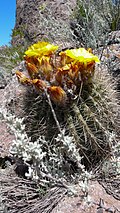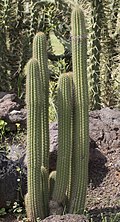| Flower | Plant | Scientific Name | Distribution |
|---|
|  | Soehrensia angelesiae (R.Kiesling) Schlumpb.
→ Echinopsis angelesiae | Argentina (Salta) |
| | Soehrensia arboricola (Kimnach) Schlumpb.
→ Echinopsis arboricola | Argentina (Salta), Bolivia |
 |  | Soehrensia bruchii (Britton & Rose) Backeb.
→ Echinopsis bruchii | Argentina (Tucumán) |
 |  | Soehrensia camarguensis (Cárdenas) Schlumpb.
→ Echinopsis camarguensis | Bolivia. |
 |  | Soehrensia candicans (Gillies ex Salm-Dyck) Schlumpb.
→ Echinopsis candicans | Argentina |
|  | Soehrensia caulescens (F.Ritter) Schlumpb.
→ Echinopsis candicans | Bolivia |
 |  | Soehrensia formosa (Pfeiff.) Backeb.
→ Echinopsis formosa | Argentina, Bolivia, Chile |
 |  | Soehrensia grandiflora (Britton & Rose) Schlumpb.
→ Echinopsis crassicaulis | Argentina. |
 | | Soehrensia hahniana (Backeb.) Schlumpb.
→ Echinopsis hahniana | Paraguay (Rio Apa) |
 |  | Soehrensia huascha (F.A.C.Weber) Schlumpb.
→ Echinopsis huascha | Argentina |
| | Soehrensia × mendocina (Méndez) Schlumpb. (S. candicans × S. strigosa) | Argentina (Mendoza) |
| | Soehrensia quadratiumbonata (F.Ritter) Schlumpb.
→ Echinopsis quadratiumbonata | Bolivia. |
| | Soehrensia sandiensis (Hoxey) Schlumpb.
→ Echinopsis sandiensis | Peru. |
 |  | Soehrensia schickendantzii (F.A.C.Weber) Schlumpb.
→ Echinopsis schickendantzii | Argentina. |
| | Soehrensia serpentina (M.Lowry & M.Mend.) Schlumpb.
→ Echinopsis serpentina | Bolivia, Peru |
| | Soehrensia shaferi (Britton & Rose) Schlumpb.
→ Echinopsis friedrichii | Argentina. |
 |  | Soehrensia smrziana (Backeb.) Backeb.
→ Echinopsis smrziana | Argentina |
 |  | Soehrensia spachiana (Lem.) Schlumpb.
→ Echinopsis spachiana | Argentina, Bolivia |
 |  | Soehrensia strigosa (Salm-Dyck) Schlumpb.
→ Echinopsis strigosa | Argentina |
|  | Soehrensia tarijensis (Vaupel) Schlumpb.
→ Echinopsis tarijensis | Bolivia, Argentina (Jujuy) |
 |  | Soehrensia thelegona (F.A.C.Weber) Schlumpb.
→ Echinopsis thelegona | Argentina |
|  | Soehrensia thelegonoides (Speg.) Schlumpb.
→ Echinopsis thelegonoides | Argentina (Jujuy) |
|  | Soehrensia vasquezii (Rausch) Schlumpb.
→ Echinopsis vasquezii | Bolivia |
| | Soehrensia volliana (Backeb.) Schlumpb.
→ Echinopsis volliana | Bolivia |
| | Soehrensia walteri (R.Kiesling) Schlumpb.
→ Echinopsis walteri | Argentina (Salta) |
|




























